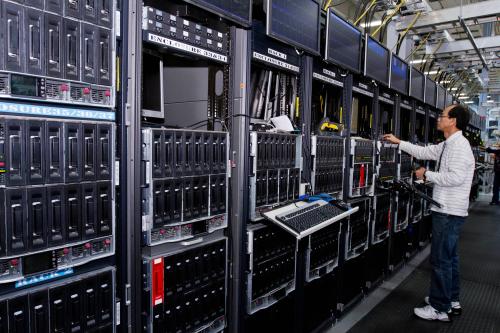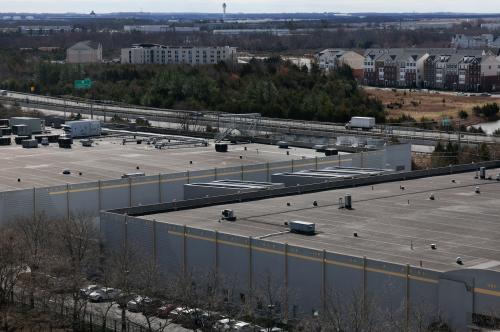Are U.S. workers now threatened by a new and powerful form of automation that could displace tens of millions from their current jobs and dislodge them from the middle class? If so, are college-educated or professional workers at the upper range of the middle class as much threatened as those with fewer such credentials at the lower end? And can policy do much to protect the middle class status of either group?
Old fears, new trends
The fear that automation will eliminate millions of jobs, leaving masses of workers jobless, has periodically emerged in industrialized countries at least since the Luddites first made that claim in Britain in the mid-19th century. In the US, such fears occasionally surface as well, as they did during a brief “automation scare” in the late 1950’s and early 1960’s, when a wide swath of workers felt some risk of displacement. To date, these fears have never proven accurate in any industrial country. New jobs always emerge to replace those that have been lost. This is true because automation raises worker productivity and reduces the costs and prices of goods and services, which makes consumers richer. They can now afford to buy more products than before, which then creates new jobs for workers to fill.
But there are costs – even for the middle class
The adjustment process I describe above does not mean that no one suffers from automation. Some workers are directly displaced from their existing jobs; perhaps they can retrain for another job in the same firm or industry, and perhaps not. Most in the latter situation become unemployed, and suffer lengthy spells without work – sometimes for years – before accepting new jobs at lower wages or leaving the work force altogether. Displaced workers who are older or less educated are more likely to leave the labor force rather than retrain for another job. For these workers, the thought of returning to a 2- or 4-year college to learn a new skill, or to start a low-wage entry level job as a trainee, is extremely unappealing – and may not be worth it if they only have a decade or two left to work. Those who were unsuccessful at school earlier in their lives, and emerged with at most a high school diploma, are especially poor candidates for more education later. And facing the prospect of nothing but low-wage work for the rest of their lives can discourage them from ever taking another job. And automation can hurt workers beyond those directly displaced. Since 1980, and perhaps well before, economists believe new technologies have been “skill-biased” – meaning that they substitute for less-educated workers broadly in the labor market, reducing the demand they face for their labor and thus reducing their wages and employment rates. In contrast, those with at least some postsecondary education, especially with bachelor (BA) degrees or higher, tend to complement the new technologies in a variety of ways – as engineers or technicians, or those who market and sell the new products, or those providing the health care that we demand with our higher incomes, or whose creativity in music or writing can now be enjoyed by vastly greater audiences. The employment rates and earnings of these complementary workers rise as a result of automation. Indeed, most labor economists believe that skill-biased technical change (SBTC) has been the largest cause of growing inequality between college-educated and other workers in the past four decades. Other forces have mattered as well – like globalization and weakening protections from unions and minimum wage laws. But new technologies have been the largest source of the new inequality. Accordingly, SBTC has made it harder for workers without postsecondary credentials, especially those without bachelor’s (BA) degrees, to join or remain part of the middle class, while those with BAs and higher have thrived. SBTC has particularly thinned the ranks of jobs in the middle of the earnings distribution for workers with high school or less education, like production and clerical jobs, which allowed workers who held them to join the middle class in larger numbers in the decades after World War II. And in regions where large numbers of these jobs have disappeared, such as the industrial Midwest and rural areas, broader declines in their local economies have hurt workers in other industries as well. Those who cannot or will not earn a postsecondary degree or relocate to an economically growing region – perhaps because of strong social ties or another barriers to work (like a substance addiction, a criminal record or a disability) – will remain in those areas and perhaps forego work permanently.
Is this time different?
While new digital technologies and other forces have caused rising inequality in late 20th and early 21st century, many Americans now fear a new and potentially more threatening form of automation, where even those with BAs or professional degrees could become displaced and dislodged from the middle class. Thus, it is possible that the employment consequences of this new automation will be more negative for the middle class than they were during any episode in the past. The greater potential for future employment loss exists because of the much greater potential reach of artificial intelligence (AI) into what have until now been exclusively human functions. AI’s ability to read patterns in the physical environment and in human interactions, as well as its ability to learn over time and adjust itself accordingly, will likely enable robots and other forms of automation to perform tasks that historically have been undertaken by humans. Some such tasks, like driving a motor vehicle in traffic or responding to customer questions and complaints in retail and service establishments, are now becoming automated and will soon eliminate several million jobs that have paid middle-class wages to workers that fill them. And, as the dexterity of robots grows, they will not only be able to perform a range of physical tasks in jobs from manufacturing to handling inventories and delivering products; they will increasingly be able to perform a range of analytical tasks in health care, legal services, accounting and finance that have required professional degrees will increasingly be within their reach. Therefore, both the lower and upper middle classes will be at risk of robot replacement, and could face lower earnings opportunities as a result. On the more positive side, the higher productivity associated with such automation will reduce production costs and prices of a wide range of goods and services, effectively raising overall incomes and consumer spending, which will then generate millions of new jobs in existing and new industries. In addition, people in the jobs being at least partially automated will increasingly be able to focus on other tasks that robots and automation still cannot perform. Various forms of social interaction, more complex modes of analyzing data and making judgments, or more creative tasks will remain primarily within the human realm for the near future. This means that, within most jobs, some tasks will be automatable and some will not. The higher the percentage of tasks in any job that can be automated, the greater the likelihood of worker displacement; and the greater the ability of the worker to learn new tasks on the job, the greater their likelihood of being retained by their employer and retooled for new tasks.
Jobs impact: what do we know?
Given these facts, can we estimate what fractions of U.S. workers face potential displacement, and in which jobs and industries? And does this information give us a greater sense of how to help more workers enter or remain in the middle class? Over the past few years, estimates of potential displacement have been generated by analysts with two kinds of information: 1) the task content of occupations today in the U.S. and other industrial countries; and 2) estimates by computer scientists of which tasks will become readily automatable over the next few decades. Of course, considerable uncertainty remains about the latter. And just because tasks become automatable doesn’t mean that they will be automated in any particular job, since the latter also depends on a range of factors including the costs of implementing the new technology, the preferences of employers for different kinds of work arrangements, and the legal and institutional settings in which such decisions occur. The extent to which workers can voice their own ideas and preferences within workplaces will also influence the nature and extent to which tasks become automated. Still, the estimates of task automation and therefore potential job displacement rates are instructive, and merit some attention here. I therefore present a few such estimates from a very recent study by economists at the Organization for Economic Cooperation and Development (OECD). OECD estimates worker displacement rates in the U.S. and other OECD countries in the next few decades, distinguishing those who will almost certainly be displaced, with task replacement rates of 70 percent or higher, from those facing high potential task replacement – in the 50-70 percent range – but who still have potential for task readjustment and retraining within their current jobs. The results show that, in the U.S. and elsewhere, about 10 percent of workers will face high risks of complete displacement, while another 30 percent or so will face significant potential task replacement risk. Some specific occupations have higher or lower potential task replacement rates, as the next chart shows:
Occupations where a great deal of routine tasks are performed, such as machine or vehicle operators and unskilled laborers, face the highest potential displacement risks; while those requiring more nuanced social interactions and analysis, like doctors, lawyers and managers more generally, face moderate risks (in the range of 20-30 percent) but will likely not be completely displaced. Viewing these estimates, it is immediately apparent that automation will continue to have a “skill bias” – in other words, less educated workers will remain at higher risk of direct displacement than most with postsecondary education, and will likely face lower demand in the labor market – resulting in lower wages and employment for them. Accordingly, not only will substantial fractions of workers face direct displacement – some of whom can be retrained for new jobs and some not – but overall labor market inequality between those with and without college education will continue to rise. Though rising productivity should help raise compensation levels overall, the skill bias of automation will likely leave many workers worse off, even if they take new jobs. In addition, those with more education will more easily retrain for new tasks at work or completely new jobs than those without it, and the better-educated will also be more open to relocating to regions with stronger economic growth. Accordingly, the more highly educated members of the middle class will continue to have higher odds of remaining there, while the less educated in the middle class may find their positions there increasingly precarious. And, if this occurs, the fallout might well be political as well as economic. The populism and nationalism that we find in industrialized democracies around the world might well grow stronger, and render politics in many countries more chaotic and polarized. This, in turn, would likely impede governments there from enacting policies to help protect the middle class from the worst effects of automation, and assist in the adjustments to labor market disruptions that will inevitably occur.
Five policies to help the middle class
A range of sensible policies at the federal and state levels can help limit worker risks of displacement and support adjustments when such displacements occur.
- Education for 21st century skills
For instance, students at all levels of education will need better preparation in what are often called “21st century skills.” These include communication and a range of social and interactive skills (such as the ability to work in teams), as well as critical thinking and various kinds of problem-solving abilities. Workers with more such skills will likely be more complementary with and less substitutable by automation, while also finding it easier to retrain for a range of new tasks that will need to be performed following automation. It thus makes sense that educators in primary, secondary and postsecondary institutions should put greater emphasis on teaching such general skills, and policies should encourage this. But the issue is complicated by the following fact: the programs that most successfully raise skills among low-income workers (when rigorously evaluated), and prepare them for possible entry into the middle class, tend to be specific to a sector with high unmet demands for workers, such as health care, advanced manufacturing, information technology, and transportation/logistics. Such programs include those based on partnerships between industry representatives and community colleges, brought together by a knowledgeable intermediary; or those more specific to employers in these industries, like apprenticeship. Of course, the narrower and more specific the training, the greater the risks of displacement for workers trained in those skills in a dynamic and uncertain future labor market. On the other hand, given the fact of high current demand and compensation for such skills, and possible entry into the middle class for workers who have them, it would make it foolish not to provide them to currently low-income workers. Still, having more of the 21st century skills would likely help workers perform better in these jobs, and make them more trainable in the future. Thus, wherever they can be provided, a good mix of general and specific skills should be imparted to those being trained for specific occupations and industries. This should be true in high-quality career and technical education (CTE) beginning in secondary school as well as in higher education.
- Lifelong learning accounts / Retraining support
Besides earlier educational preparation, what more can be done to help workers adapt when automation threatens them with job displacement? Financial support for retraining could be important here, and two forms of such funding could particularly help. First, states can create personal “lifelong learning” accounts into which workers pay a small percent of payroll each period, thus creating a fund for new education or training if/when displacement occurs. Indeed, the states of Maine and Washington already do so, and more might soon join them. Second, federal or state governments can provide financial and technical assistance to firms for on-the-job training, thereby encouraging employers to retrain rather than displace their employees. This will have some appeal to employers, since it will enable them to retain employees with good track records, and avoid recruitment and screening costs for new employees of uncertain ability. And the new expenditures could perhaps be financed by a new tax on worker displacement, since these impose a cost on society which employers should be required to partly carry.
- Workforce support
A wider range of additional policy initiatives could help as well. First, a more robust set of workforce services would help workers reeducate and relocate themselves. Information on career and training options as well as new jobs are available to workers at over 3000 of “America’s Job Centers” (formerly called One-Stop offices) around the country, though their funding and therefore their staffing quality has been quite limited. Improving the academic and career guidance available at community colleges would be very important as well.
- Wage insurance
Many workers who will be displaced over time but not retrained will likely face a future of lower wages than before or no work at all. For them, some form of “wage insurance” makes sense. Such a program would compensate displaced workers for some part of their job loss – say, half – for a period of years. Thus, workers who formerly earned $30 an hour but only $20 now would receive $5 from the government for a period of time, such as five years. They would therefore be incentivized to work and would also receive needed financial assistance at the same time.
- Unemployment and Disability Insurance reform
Finally, a set of reforms in our Unemployment and Disability Insurance systems might be warranted too. Reforms in the former might encourage them to obtain new training while they receive their stipends, while those in the latter would encourage workers and employers to engage in work rather than permanent lack of work for those with only moderate conditions. I believe this set of proposals makes vastly more sense than others, like guaranteed public employment or universal basic income payments, which would be hugely more expensive to implement and would not incentivize everyone to do whatever is necessary to stay employed.
- Employers: Take the high road
Though most of our policies above are aimed at helping workers adjust to automation, we should also have an overall policy goal for the employer side of the job market: encouraging them to take the “high road” in worker compensation and to actively invest in their employees as workplaces automate, to increase their productivity and performance. Economists have long argued that, in many industries, employers have some choice over whether to compete on the basis of high worker productivity and performance or merely low labor costs. Employers choose between these strategies, often called “high road” and “low road” approaches, early in the lives of their establishments, though they can also shift their strategies over time. Since “high road” employers invest more in their workers’ skills, and often allow them more “voice” in the operation of the workplace, they will be more open to implementing new automation in ways that are “worker-friendly” and to retraining them over time. Such approaches should be encouraged by policy at all levels. Overall, the policies I propose will not completely protect the middle class from the disruptions and displacements they will likely face in the coming decades. But they will certainly help millions of workers join this class or remain there in the face of displacement risks, and will raise the net positive effects on workers that always result from automation.
The Brookings Institution is committed to quality, independence, and impact.
We are supported by a diverse array of funders. In line with our values and policies, each Brookings publication represents the sole views of its author(s).







Commentary
The robots are coming. Let’s help the middle class get ready.
December 13, 2018